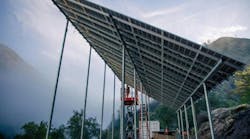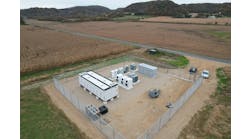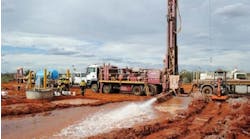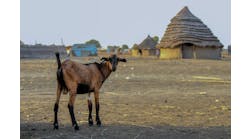The need for resilient health care facilities — via microgrids — on tribal lands is hiding in plain sight, said Thomas Tighe, president and CEO of Direct Relief, a humanitarian aid organization.
“A lot of people think about power, but those who think about health don’t think about power,” he said. “Resilient power is a thing of value but the payoff may not seem compelling.”
But if a hurricane takes out power for many months or even years, many people likely will have no access to health care or electricity to power medical devices and refrigerate vaccines and medications. Often the value of resilient power to address these challenges isn’t included in cost-benefit analyses.
“It’s hard not to see its benefit once you’ve seen the consequences,” Tighe said.
Grants through Power for Health program
To address the often overlooked need for resilient health care facilities on tribal lands, Direct Relief is providing $10 million in grants for solar and storage microgrids that will serve tribal communities that experience frequent power outages. The grants are being offered through Direct Relief’s Power for Health initiative, which aims to help ensure the U.S. nonprofit health care safety net is more resilient and better equipped to operate through disaster-caused blackouts.
The grants cover the cost of designing and installing solar and battery systems, which are then owned and maintained by the health organizations. The grants aim to provide energy resilience, lower the burden of energy costs and make health care facilities more economically sustainable.
In the 1930s, many tribal communities not electrified
Tribal communities’ lack of access to reliable power dates back to the 1930s, when the U.S. first began electrification efforts, said Kimberly Dutcher, government relations adviser for Native American Affairs at Direct Relief, and former deputy attorney general for Navajo Nation. The government’s goal was to mainstream Native Americans, and it did not focus on electrifying tribal communities.
As a result, Native American communities often lack reliable power and are subject to numerous and often long outages.
In fact, about 30% of those in Navajo Nation lack access to electricity, she said.
“The federal government, through treaty obligations, promised to provide health care through the Indian Health Service set up on tribal lands,” Dutcher said. But providing health care has been a challenge, given that the communities have fragile or nonexistent electricity.
When Dutcher served as deputy attorney general for Navajo Nation in Window Rock, Arizona, weekly outages were common, she said.
DOE report highlights energy challenges for Native Americans
An August 2023 report from the U.S. Department of Energy (DOE) emphasized the need for resilience in tribal communities. It found that these communities, generally served by rural electrical cooperatives, frequently pay a higher-than-average rate for electricity and funnel a higher-than-average proportion of their income into energy costs. They have a high proportion of unelectrified homes and are subject to electric reliability challenges, along with high poverty levels.
In addition, the report said that American Indian and Alaska Native communities are vulnerable to extreme weather and climate change that can undermine electric reliability. In Alaska, which is home to 40% of federally recognized tribes, reduced sea ice and higher temperatures threaten traditional livelihoods and infrastructure.
Tribes on the East Coast and Gulf Coast are experiencing more frequent power outages from more intense hurricanes, while tribes in the western U.S. may see more outages from frequent droughts and wildfires, said the report. In addition, tribes are located in areas – like California – where utilities implement public safety power shutoffs in response to wildfires.
A perfect storm for health risks
This is “a perfect storm of circumstances” that has led to a lack of adequate health care, said Dutcher. In fact, between 2019 and 2021, Native Americans’ life expectancy dropped from 71.8 years to 65.2 years, largely because of the COVID-19 pandemic. Native Americans’ preexisting health challenges and lack of health resources contributed to the drop in life expectancy, said Dutcher.
As part of its effort to support communities that lack resilient power or are hit by disaster, Direct Relief in 2018 installed a microgrid at its 155,000-square-foot warehouse in Santa Barbara, California, to help ensure it could provide medical supplies during energy emergencies.
“Puerto Rico lost all the drugs on the island after Hurricane Maria,” said Tighe. “Outages causing loss of power mean people can’t power home medical devices and refrigerate medicines like insulin.”
The $10 million for solar and storage microgrids comes from philanthropic funds, which are more flexible than government funds, said Tighe.
Each microgrid system will be customized to meet the needs of the health care facility, said Tighe. Direct Relief is focusing on tribal lands in the Midwest, Southeast and Alaska, he said.
DOE Loans Program Office gives partial loan guarantee to tribe
Other efforts to provide resilience to tribal communities include a conditional commitment from the DOE's Loan Programs Office to give a $72.8 million partial loan guarantee to the Viejas Band of the Kumeyaay Indians for the development of a solar plus long-duration energy storage microgrid.
The utility-scale renewable microgrid will be built on tribal lands near Alpine, California, just east of San Diego. Indian Energy, a 100% Native American-owned energy development firm, is developing the project, which will include a 15-MW solar array and a 38-MWh long-duration energy storage system.
In addition, the U.S. Department of Energy announced in July 2023 that it would provide $14.7 million for a multiyear research, development and demonstration of microgrid and related technologies for underserved and indigenous communities.
Blue Lake Rancheria microgrid helps save lives and cuts emissions
One well-known microgrid serving a tribe is the Blue Lake Rancheria facility, which has operated through numerous outages in California. In fact, in 2019, the Blue Lake Rancheria microgrid likely saved four lives when its owner welcomed in the broader community during California’s wildfire related power shutoffs. The microgrid helped provide the community members with power for medical equipment.
Helping save lives wasn’t the only advantage of the microgrid. During the microgrid’s first year of operation, which was only for part of the year, it reduced the tribe’s greenhouse gas emissions (GHG) by about 175 tons and lowered its energy costs by about $195,000. Going forward, the tribe estimated the microgrid will reduce its annual GHG emissions by 200 tons and cut its annual costs by more than $200,000.
As Tighe said of microgrids in tribal communities, “the benefit is very high.”








